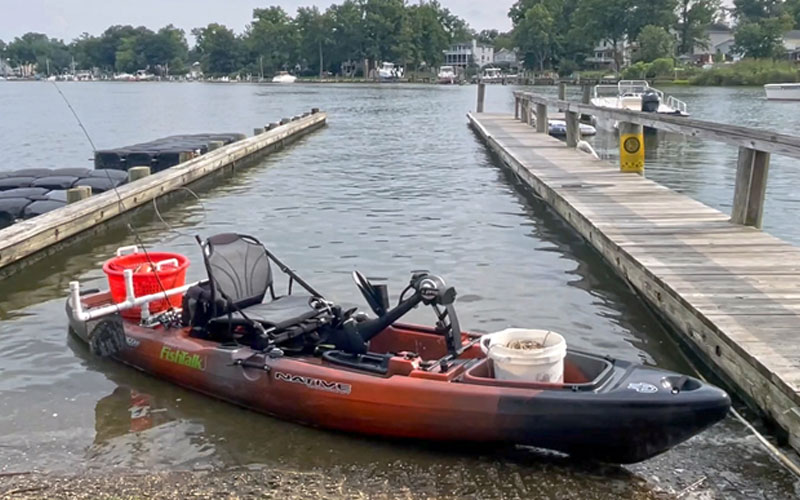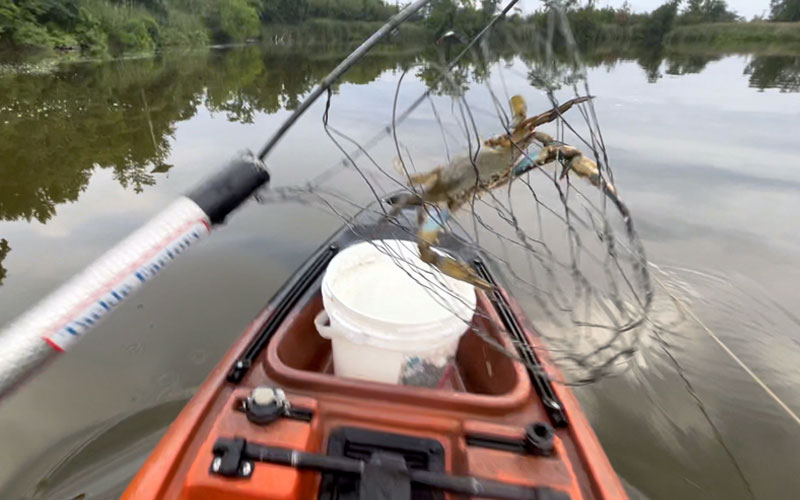While there are several options for kayak crabbing, from handlining to pull traps, a trotline is by far the most effective way to catch crabs and load your bushel basket. Aside from setup, kayak trotlining is not all that different than operating from a boat (For more trotlining tips visit: fishtalkmag.com/blog/crabbing-trot-line-tips-pro.) Let’s look at the basics for how to catch crabs by rigging and running a trotline from a kayak.
First off, you’ll need to be hands free, so a pedal powered kayak or one fitted with an electric motor is a must. For simplicity’s sake, I’d recommend the pedal option. You’ll need to either purchase a “stick” or build one of your own. I used existing track mounting on the Boonedox Landing Gear on my Native Watercraft Slayer Propel 13 to create a PVC trotline stick assembled with stainless screws and reinforced with a wooden dowel. I zip tied a foam flap to eliminate the snoods from flipping over and snagging while underway.

A 600-foot trotline is an adequate length for crabbing from a kayak. You can pick one up at your local tackle shop or rig up your own. Fasten a few feet of chain to each end of your trotline using brass clips. Tie off the chain to 10 to 15 feet of line to large, brightly colored, matching floats (marked with your DNRid in Maryland; a recreational crab license is required in most states for use of a trotline). Then attach another 10 to 15 feet of line from the float to a small mushroom anchor. You will need to do this for both ends of the trotline.
The modern plastic bushel baskets are great for transporting your crabbing gear and holding your catch on the water. Take along a rag towel or burlap sack and soak periodically to keep the crabs lively. These orange plastic baskets are slightly larger than the old school wooden baskets. So, if the crabbing is on fire, be sure not to fill to the brim, as you will be slightly over your one-bushel daily limit. The wooden baskets are fine too, but I’ve found that the sharp metal edges don’t always play nice with plastic kayaks.
A three-gallon bucket is the perfect size for storing your 600-foot trotline. When baiting your snoods, carefully lay the line into the bucket on top of itself in a circular motion to avoid snags and tangles when deploying. Once your trotline is in the water, this bucket is perfect for culling your crabs on each run. Keep it in the bow of your kayak and dump any qualifying crabs that you scooped up into the bucket. Then measure your crabs before dumping them into your bushel basket.

I use a metal dip net with an aluminum handle that I cut in half for ease of use on my kayak. If your kayak does not already have them, adding rod holders is a convenient way to carry your net. I usually carry a light tackle rod to give the crabs a break and catch a few fish. If I am losing a lot of baits, I will sometime add a few pieces of fresh cut perch or spot to the line. Once I do so, those snoods tend to outperform the old soggy chicken necks.
A few other pieces of essential gear include rubberized gloves for deploying the trotline and handling crabs, a measuring stick or ruler, and a pair of tongs. I hope this information helps you catch more crabs from your kayak.
~ By Zach Ditmars